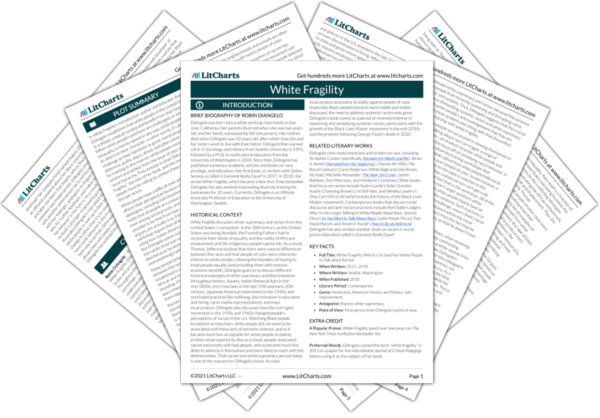Summary
Analysis
In one of DiAngelo’s workplace workshops, a white woman named Karen got upset when her only colleague of color, Joan, pointed out that Karen often talks over her. Karen didn’t understand what that had to do with race, and she exclaimed that she was going to stop talking altogether because she couldn’t say anything right. This highlights Karen’s white fragility because she positioned herself as the one who was being treated unfairly. In an NPR poll, a majority of white people believe that discrimination against white people exists, but a much smaller percentage say that they have experienced it.
Karen’s reaction is a classic example of white fragility. It deflects from the issue at hand, and makes the conversation more about her own feelings than about Joan’s. Many white people believe that white people are victims of discrimination, but this is more of a prevailing narrative (determined by white supremacy) than what most white people personally have experienced.
Themes
Despite its ubiquity, white superiority is often unnamed, as white people often deny race-based privileges. For example, the 2016 Oscars were challenged for their lack of diversity. Actor Helen Mirren responded that it “just so happened that way,” while actor Charlotte Rampling called the idea of a boycott of the Oscars “racist against whites.” Self-defense is a prominent position to protect white people, claiming that it is they who have been unfairly treated.
Again, white people rely on ideas of meritocracy (the idea that success is based on hard work) and objectivity (the false idea that white people can be without bias) to deflect from legitimate claims of discrimination. Rampling’s statement that boycotting the Oscars would be “racist against whites” not only misunderstands racism as systemic privilege that white people do not experience, but also ironically acknowledges the fact that the Oscars are dominated by white people.
Themes
When DiAngelo consults with organizations, she is often warned that past efforts to address a lack of diversity have resulted in “trauma” for white employees, and that DiAngelo should tread lightly and cautiously in her workshops. Of course, this so-called trauma has ensured that the organization has remained overwhelmingly white. Because the climate in the U.S. forbids the open expression of race-based feelings, white people become incomprehensible when talking about race.
The use of the word “trauma” is ironic, as it distorts the actual trauma that white people have perpetrated against people of color. The idea that having to take a workshop to address lack of diversity is a comparable trauma only emphasizes exactly how “fragile” white people can be, as in the book’s title.
Themes
Another example of white fragility in DiAngelo’s workshops came when she was co-facilitating an interracial group. One participant was upset at receiving feedback on how some of her statements impacted people of color in the room. After a break, her friends alerted DiAngelo that the woman was in poor health and thought she might have a heart attack. As a result, all the attention immediately focused on the white woman and away from her impact on the people of color.
This is a classic example of white fragility, as the woman’s inability to receive feedback becomes the room’s focus, rather than the racist behavior she perpetuated and how she might change that behavior going forward.
Themes
Get the entire White Fragility LitChart as a printable PDF.

White fragility is a form of bullying, making it so unpleasant to confront white people that others will simply back off and give up. As such, it is a means of maintaining white supremacy. DiAngelo often asks people of color what it would mean for white people to simply receive feedback, reflect on it, and work to change the behavior. One man of color said, “it would be revolutionary.”
White fragility works in tandem with white supremacy, because it maintains the racial status quo. The man’s belief that receiving, reflecting, and working to change behavior would be “revolutionary” shows how addressing white fragility is a crucial first step in then being able to address white supremacy and racism on a systemic level.
Themes












